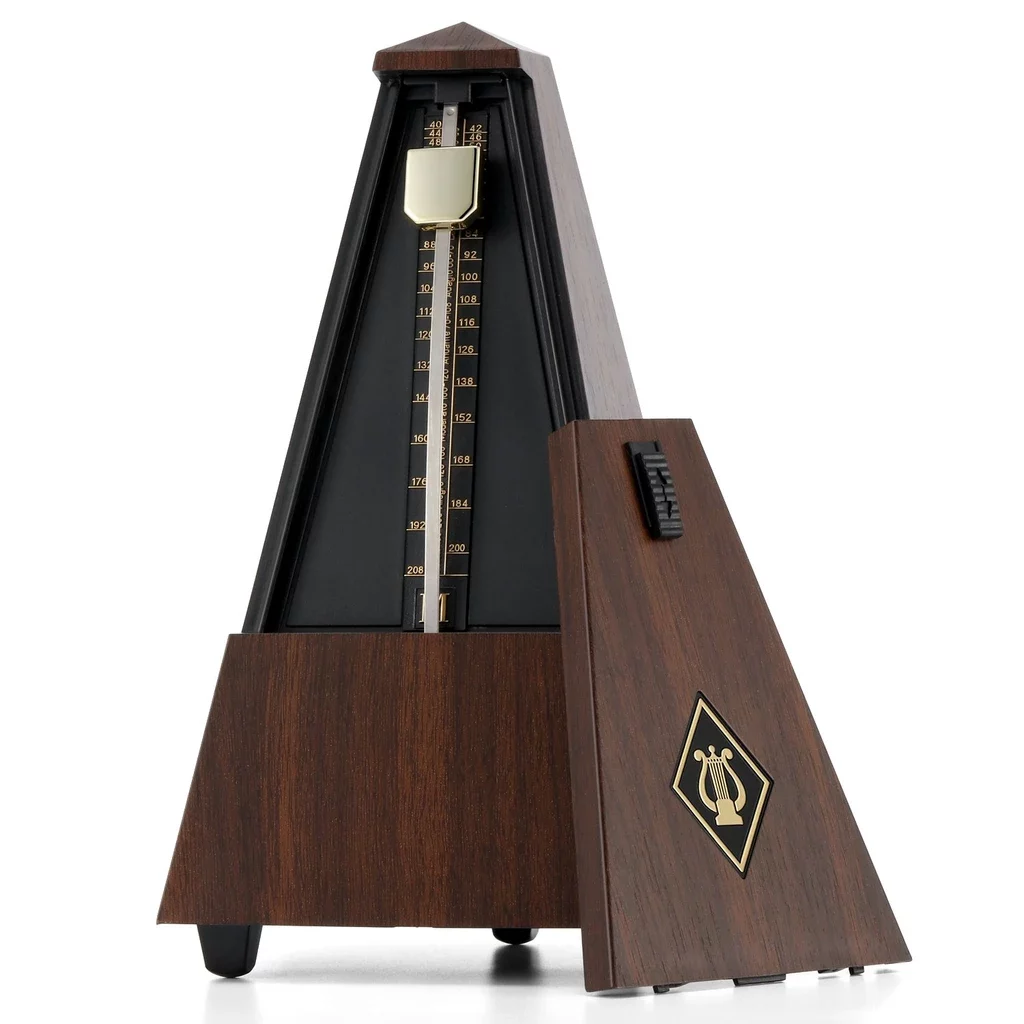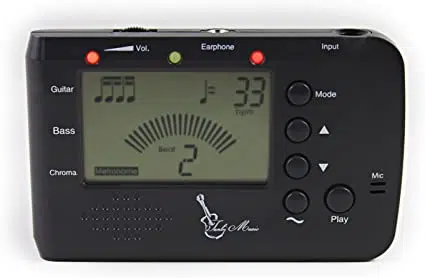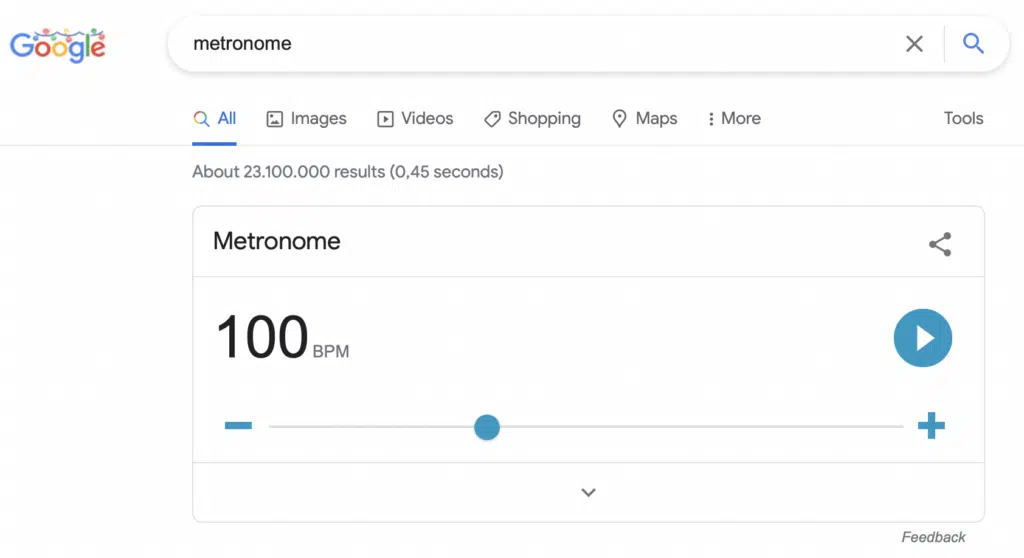Do you want to be a performing musician but are worried about your wrong timings? Do you want to improve your rhythm? Do not worry, the metronome is your friend and this guide will help you understand how to practice with a metronome.
What is a metronome?
A metronome is a musical device that assists you with the rhythm of the notes. It helps by producing sounds at regular set intervals. Once you learn how to practice with a metronome, you can quickly and efficiently learn rhythmic and technical music skills. A metronome may help you with any musical instrument.
Types of Metronomes
There are four big categories of metronome types. The classic or analogue, electric or digital, online and app metronomes. None of them is inherently better than the rest, pick whatever you feel most comfortable with.
Classic Metronomes
Classic metronomes work manually. They don’t need an electric supply or a battery to work. Moreover, they give a vintage look which some people love. Though these metronomes can provide a steady tempo, their accuracy cannot compete with digital metronomes.

These metronomes have an inverted pendulum rod with an adjustable metal piece. You can change the tempo by moving the metal piece up and down the pendulum. If you need a slower tempo, slide the weight up the pendulum and vice versa. These metronomes are also known as analogue or old fashioned metronomes.
Electric Metronomes
Most metronomes available on the market nowadays are electric metronomes. These are digital metronomes that need an electric supply or battery to work. You can easily get these metronomes from any music store.

The working principle of an electric metronome is like that of a wristwatch. It has a quartz crystal inside it that maintains its accuracy to an extreme level. These metronomes have a simple on/off button. In an advanced electric metronome, there may be many other features such as multiple tones, different tempos, flashlights… that can help you in any way.
Online Metronome
Open google and type “metronome online”. Google will show you one, but there are a lot of websites that offer a free metronome as well. You can typically set any tempo and subdivision to make a specific time signature. An online metronome has a couple of very useful features, such as the tap feature, volume control, two beats at a time and many others.

Metronome Apps
You can also download a metronome application on your android or iOS smartphone. Just go to the play store and search for a metronome. Some of these applications also work even if you don’t have an internet connection. However, for some features, an internet connection might be required. Try out several applications and choose the best one for your practice sessions.

Metronome Features
Flash Light
Some of the latest metronomes have this flash feature. Instead of the sound, the flashlight turns on and off at a steady beat. For mobile applications, it uses the flashlight of your mobile. This comes in handy when you don’t want the sound of the metronome to disturb while you’re playing.
Different Tone
You may have heard the familiar clicking sound of a wall clock before. The same sound is used for most metronomes. However, some metronomes come with various sounds so that you can select the sound he wants.
Counting
Some metronomes come with a counting feature instead of a standard tick tick sound or some other beep sound. This allows you to keep the music aligned with your beats.
Tap Feature
The tap feature can also be found in many online metronomes. This feature allows the player to check all the beats and select a tempo that he needs to practice. It is helpful for those who don’t know what their standard tempo is.
Subdividing Feature
Understanding rhythm is very important in music and the metronome teaches you this. The subdividing feature of the metronome allows you to break large beats into smaller units to make them easy to perform.
How To Use A Metronome
To measure the time difference between two beats, we use a unit known as BPM or Beat Per Minute. It means that if it’s 60 BPM, it means one beat per second. Practicing with a metronome is quite simple if you follow these practice tips.
Try To Feel The Beat
If you don’t have a strong inner sense for tempo, try to focus on the beats of the metronome without playing the ukulele. You can nod your head with the beat or tap your feet. This will help your body “feel” the beat. Just spend a few minutes doing this during a practice session. The more time you give to it, the more you become familiar and used to it.
Keep Your Starting Tempo Slow
Start slow and gradually increase while you learn practicing songs with a metronome. Starting with a fast tempo may not be as fruitful as with a slow tempo. Select the tempo you feel comfortable playing with. Once you get used to that tempo, increase the tempo by a few beats. This is one of the best tips I’ve got personally when I started learning new fingerpicking songs on the ukulele.
The metronome helps the musician to increase his/her music pace. For example, you want to play a song at 100 BPM. However, it is not possible to play at this tempo instantly. Start with an extremely slow tempo of 40-50 BPM or whatever you feel comfortable with. Once you feel that playing at this tempo is no longer a problem, increase it by a few beats, let’s say 5 BPM. This way, keep increasing the tempo gradually until you get the target tempo achieved.
Subdivide Difficult Rhythms
Most metronomes come with a subdividing feature. For example, if you can’t line up quarter notes to 60 BPM, then just set your metronome to 120 BPM and try to feel the eighth notes. This way you can divide larger rhythms into smaller units and learn them one by one.
Practice Simple Exercises
Instead of practicing difficult exercises, go for simple exercises and try not to make a single mistake during your practice session. The metronome will also teach you gradually how to go with scales and some other technique exercises.
Conclusion
A metronome can be very useful for those who have problems playing the instrument with rhythm. However, some professional musicians still say that they practice daily with a metronome.
In this guide we discussed the several types of metronomes, their features and how to practice with them. Practice makes perfect! Keep practicing until you learn to play with the same tempo without a metronome. Feel free to share your experiences with a metronome in the comment section.
NEED MORE INPUT
Feel free to contact me whenever you need more information about how to practice with a metronome. This guide was written in conjunction with InstrumentBuzz.
Interested in warming up exercises or how to strum a ukulele as well?
